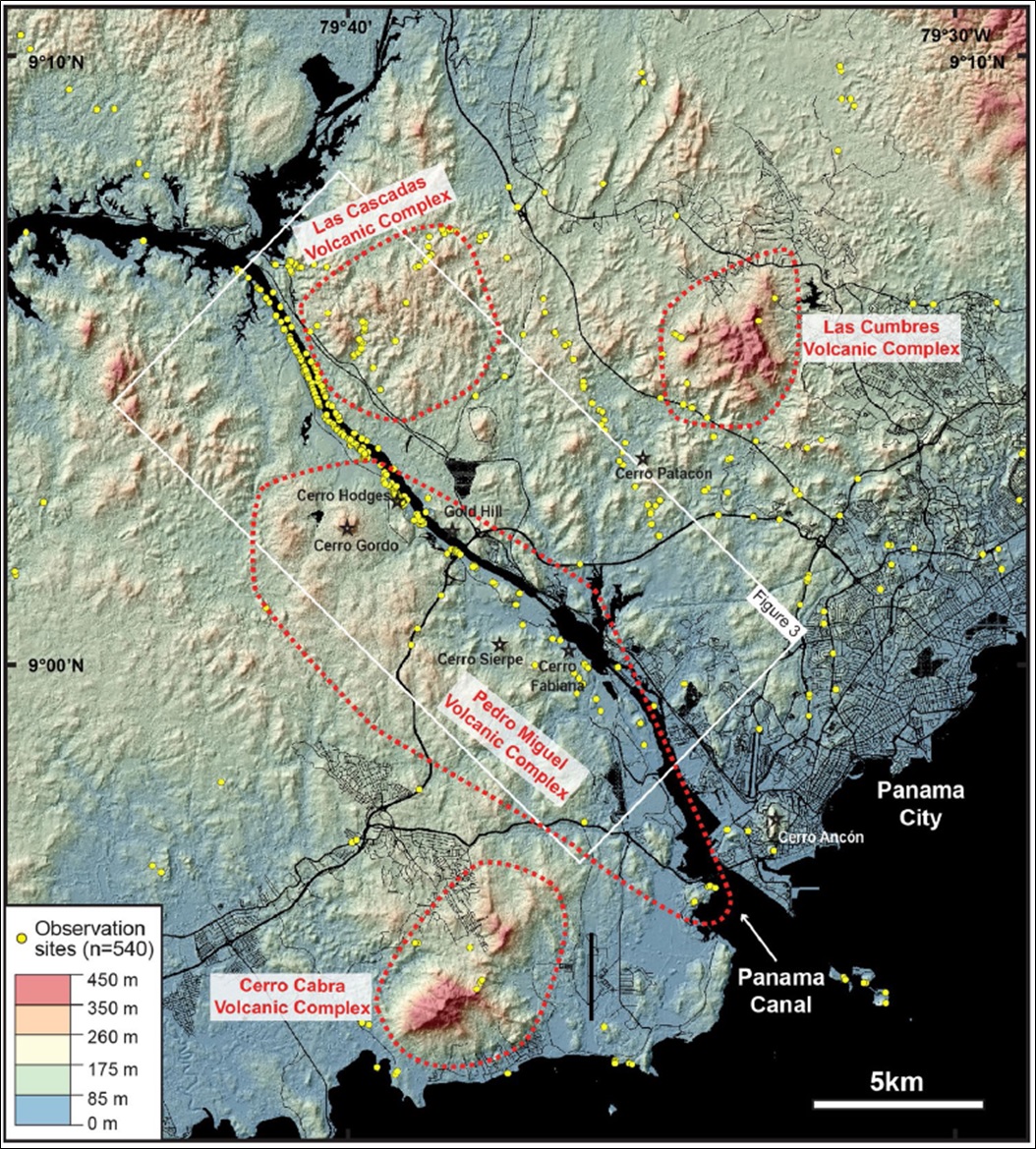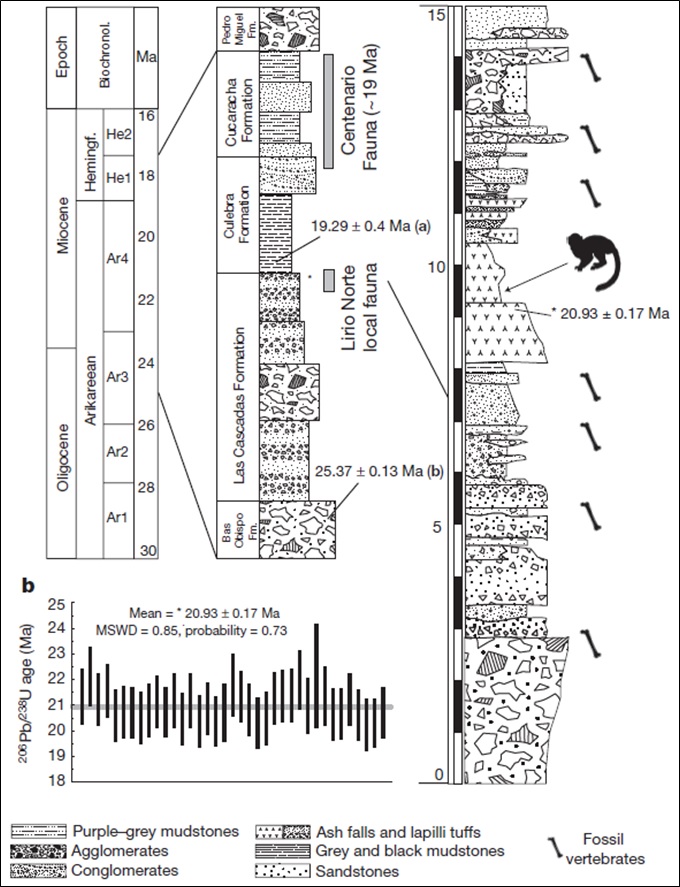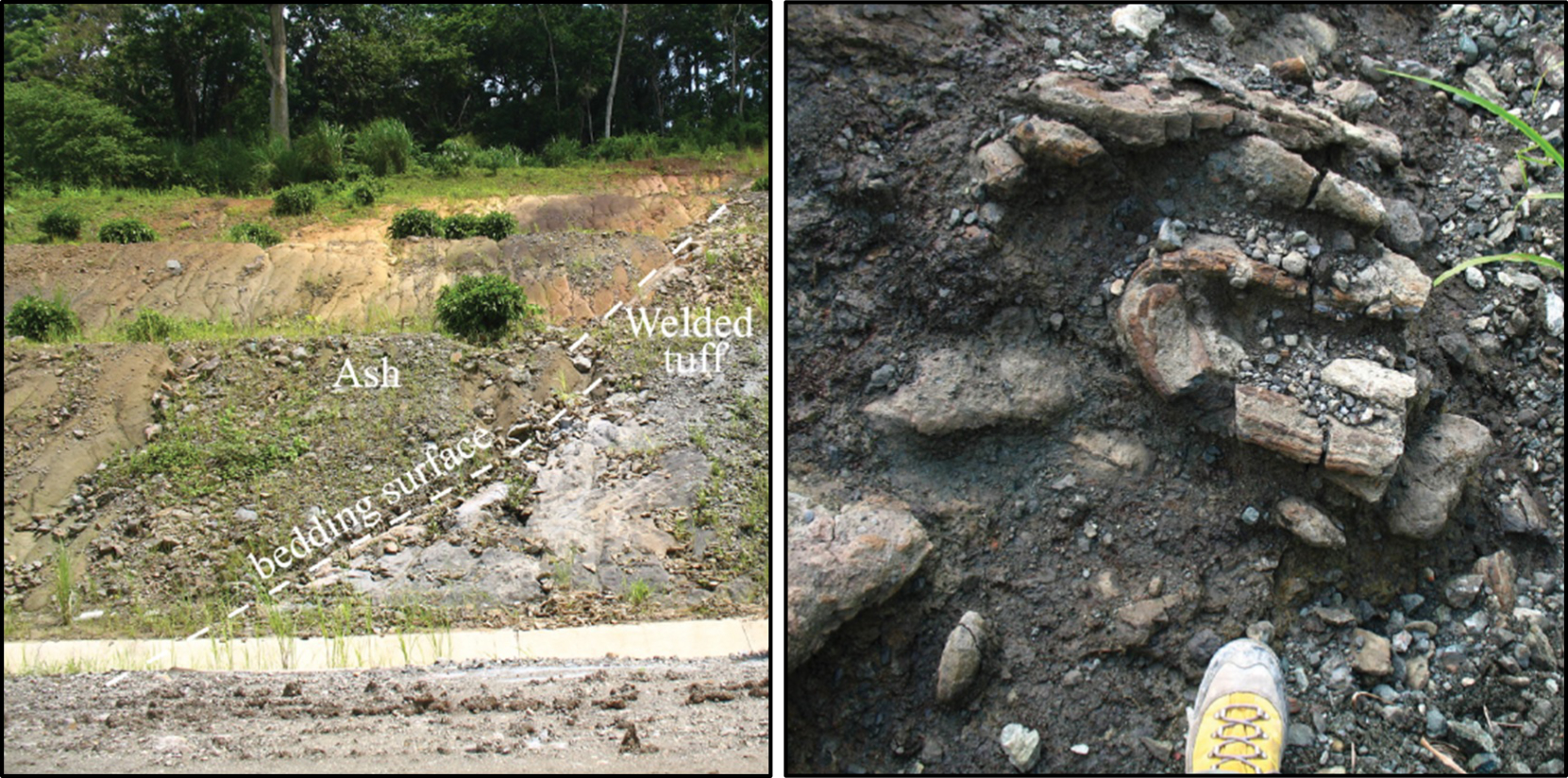Las Cascadas Fm
Type Locality and Naming
[Figure 1: (left) Topography of the Central Panama in the southern Panama Canal area and its main volcanic complexes (Buchs et al. (2019)). Digital topography model based on Lidar survey by the Panama Canal Authority. The geological details of the area within the white rectangle (figure 3 of Buchs et al. (2019)) can be seen in right. (right) Geology of the southern part of the Panama Canal (Culebra Cut and new Pacific locks area). (A) Revised geological map. (B) Revised chronostratigraphic chart with previous and new geochronological constraints (new data in dark circles and bold text) (Buchs et al. (2019)).]
Synonym: Las Cascadas Agglomerate; Las Cascades Fm
Lithology and Thickness
In Buchs et al. (2019), the Las Cascadas Fm is characterised by an abundance of welded pyroclastic density currents (PDC) deposits, or ignimbrites, that are generally thick (locally > 10 m). The Las Cascadas ignimbrites are commonly interbedded with fallout fine tuff to coarse lapilli-tuff, with locally large cm-sized accretionary lapilli and intermediate-felsic lithics (Figure 5, left). These deposits are associated with red to white tuffaceous paleosols that often preserve an original pumiceous fabric or are mottled (Figure 5, right & Figure 6). The paleosols are locally interbedded with lenses of cross-stratified sandstone to breccia, with abundant clasts of dacites and occasionally amoeboid/juvenile andesite (?) clasts (Figure 6). Agglomerates were not observed, but rare possible occurrences of channelized lahar deposits are found. All of the preceding tuffaceous deposits are grouped here in the newly-defined Tuff Member of the Las Cascadas Fm (Figure 1). This unit corresponds to the original Las Cascadas Fm on the regional geological map and could extend laterally to the upper (tuffaceous) Member of the Caimito Fm in the Lake Gatún area.
Other volcanic deposits in the Las Cascadas Fm consist of flow-banded greenish dacite lavas that are restricted to the NE side of the central Culebra Cut (Figure 5, right), and rare brecciated dacite dykes in fault zones. These rocks are interbedded with, or crosscut, tuffs similar to those described above. The dacite lavas can be followed to the NE of the Canal in river exposures, where they are associated with dacitic-rhyolitic intrusions and correlate to a topographic high (Figure1). These dacite-rich sequences are part of a newly-defined Dacite Member of the Las Cascadas Fm (Figure 030), which replaces some of the undifferentiated felsic igneous units on the original geological map (Buchs et al. (2019)).
Thickness: ~390m
[Figure 2. Stratigraphy of the primate-bearing locality in central Panama. Measured stratigraphic section (in metres) in the Las Cascadas Fm showing the positions of the dated rock sample (asterisk) and of the Panamacebus fossils as a silhouette of a monkey (right), correlated to a schematic stratigraphic position of the Lirio Norte Local Fauna and the Centenario Fauna with previously published radiometric dates indicated (centre), and North American land mammal faunal zonation (left). Hemingfordian North American Land Mammal Age. Bloch et al. (2016)]
[Figure 3. Field photo of the contact between a welded silicic pyroclastic bed and an ash fall tuff layer typical of the Las Cascadas Fm (left). Ropey andesitic lava. Photos from Farris et al. (2017) (right).]
[Figure 4. Lithic-rich pyroclastic density current deposit in the Las Cascadas Fm. Inset shows a large lithic of flow-banded dacite (left). Pumice-rich pyroclastic density current deposit in the Las Cascadas Fm. Buchs et al. (2019) (right).]
[Figure 5. Fallout coarse lapilli-tuff with accretionary lapilli in the Las Cascadas Fm (up). Flow-banded dacite lava flow on top of a paleosol in the Las Cascadas Fm. Thickness of the flow is approximately 5 m. Buchs et al. (2019) (down).]
[Figure 6. Tuffaceous paleosols of the Las Cascadas Fm. Inset shows a lens of cross-bedded volcanogenic sedimentary breccia (left). Cross-bedded volcanogenic sedimentary breccia and coarse sandstone in the Las Cascadas Fm, with clasts of amoeboid andesite/dacite in the inset. Buchs et al. (2019) (right).]
Relationships and Distribution
Lower contact
Upper contact
Regional extent
GeoJSON
Fossils
Age
Depositional setting
Additional Information
References:
- Woodring & Thompson (1949). Las Cascadas agglomerate, Bas Obispo Fm, and Bohío Fm, all tentatively considered early Oligocene in age, are the oldest formations along the Canal. Las Cascadas agglomerate and pyroclastic Bas Obispo Fm are interpreted to represent accumulation of volcanic products at periphery of a volcanic pile. Unconformably underlies Culebra Fm.
- Jones S.M. (1950);
- Woodring (1957). Overlies Bas Obispo Fm. Las Cascadas agglomerate and the Bas Obispo probably would ordinarily be combined as one formation; however, they differ in induration. Matrix of Las Cascadas consists of soft fine-grained altered tuff and bentonitic clay. Thickness not determined. According to plate 1, near Gamboa agglomerate rests on Bohío Fm, Gatuncillo Fm, or basement complex; confirmation of this overlap is needed; in eastern part of Gatún Lake area, appears to grade into Caimito Fm. No fossils present; doubtfully referred to Oligocene because of inferred relations to Bohío and Caimito Fms.
- Woodring (1960); Woodring (1982); Kirby et al. (2008); Montes et al. (2010); Rincon (2011); Rincon et al. (2012a, 2012b, 2013); Head et al. (2012); Montes et al. (2012b); Hastings et al. (2013); Rincon et al. (2015a, 2015b); Wood et al. (2015); Bloch et al. (2016); Farris et al. (2017); Buchs et al. (2019);





